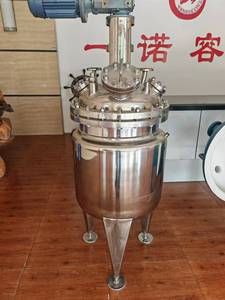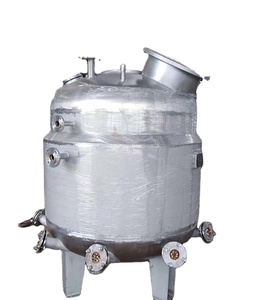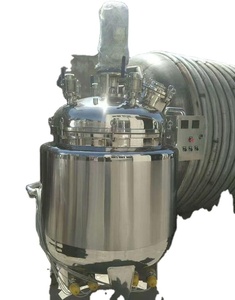
All categories
Featured selections
Trade Assurance
Buyer Central
Help Center
Get the app
Become a supplier

(457 products available)




















A 100L hydrogenation reactor is a type of chemical reactor that enables hydrogenation reactions to occur. Hydrogenation is a process that involves adding hydrogen to something, usually unsaturated organic compounds like fatty acids. This process requires the use of specialized equipment and reactors known as hydrogenation reactors. There are three main types of hydrogenation reactors: batch reactors, semi-batch reactors, and continuous reactors.
Batch hydrogenation reactors
A batch hydrogenation reactor is a vessel where hydrogenation occurs in batches rather than continually. The batch hydrogenation reactor allows for the addition of reactants to the system and subsequent removal of products after the respective chemical reaction is completed. With a batch hydrogenation reactor, it's possible to change the reaction's conditions and parameters whenever a fresh batch of unsaturated organic compound is introduced to the system. This easily caters to different types of organic compounds. However, the drawback of a batch hydrogenation reactor is its low efficiency because it takes a long time for every phase of the process to occur, including filling, reaction, and emptying.
Semi-batch hydrogenation reactors
A semi-batch hydrogenation reactor is similar to a batch reactor, but reactants can be added to the system during the process of reaction. This continuous addition of fresh reactants while the reaction is still on-going helps to increase the reactant-to-product ratio. This, in turn, improves the overall efficiency of the hydrogenation reaction. Semi-batch hydrogenation reactors are also suitable for dealing with heterogeneous reactions.
Continuous hydrogenation reactors
A continuous hydrogenation reactor is a type of reactor where both the process of feeding reactants into the system and the production of products occurs continuously over a span of time. Continuous hydrogenation reactors make use of tubular or packed bed reactors. Continuous hydrogenation reactors are suitable for large-scale production of hydrogenated organic compounds.
Industrial hydrogenation reactors are widely used in the chemical and pharmaceutical industries. Here are some scenarios of how these reactors are used.
Scent Composition Engineering
In perfume manufacturing, the 100L hydrogenation reactor can be used to create a base for scents or modify natural extracts. For example, the unsaturated essential oils in the hydrogenation reactor are saturated to enhance the thermal stability and shelf life of the perfume.
Chemical Production
In chemical engineering, various chemical compounds are produced through the hydrogenation of unsaturated compounds to form new chemicals, like solvents, chlorinated hydrocarbons, and alcohols, among others. Hydrogenation reactors are critical equipment for making these products.
Modification of Raw Materials
The hydrogenation reactor can improve the properties of raw materials. Take, for example, vegetable oils. They are saturated in the hydrogenation reactor to produce shortening and margarine with a longer shelf life, which remains solid at room temperature. This process is widely applied in the food industry.
Pharmaceutical Production
In the pharmaceutical manufacturing industry, drug intermediates or active ingredients are produced by hydrogenating unsaturated organic compounds in the reactor. For example, morphine and L-DOPA are made through hydrogenation reactions, which are core components in analgesic and Parkinson's disease medicine respectively.
Fine Chemical Engineering
In cosmetics or detergent production, the 100L hydrogenation reactor is used to produce surfactants, emollients, or other functional ingredients. For example, lauryl alcohol is made through hydrogenation reactions, which serve as an important raw material in making surfactants.
Resin Hardening
In the coating or adhesive manufacturing industry, vegetable oils and alkyd resins are hydrogenated to enhance their heat resistance, aging resistance, and water resistance through the reaction in the hydrogenation reactor.
Research and Development
In a laboratory setting, a 100L hydrogenation reactor can be used for scientific research and experimentation, such as exploring new reaction pathways, optimizing reaction parameters, or testing new catalysts.
When purchasing a 100-liter hydrogenation reactor, the following factors will help make a good choice.
Process requirements
Determine the chemical process requirements, including reaction types such as hydrogenation, oxidation, or esterification. Consider factors such as operating temperature, pressure, and the need for catalyst addition or removal.
Materials compatibility
Choose a reactor construction material compatible with the intended reaction and the substances involved. Avoid material degradation, leakage, or contamination of the product.
Design and capacity
Select a reactor design, such as stirred tank, tubular, or airlift, based on the process requirements. Consider factors such as heat transfer, mass transfer, and the need for in-situ catalyst regeneration or hydrogen addition. For batch processes, choose reactor volume based on the desired batch size and the availability of raw materials. For continuous processes, consider the feed rate and the steady-state material balance.
Operating conditions
Consider the operating temperature and pressure range of the reactor. Select a suitable reactor liner, insulation, and pressure vessel design to maintain safety and performance.
Agitation and mixing
For reactors requiring agitation or mixing, choose an appropriate agitator type and design. Consider factors such as the reaction kinetics, the desired mixing intensity, and the operating environment.
Instrumentation and control
Select appropriate instrumentation and control systems for real-time monitoring and feedback control of the reactor's operating conditions. Ensure the availability of safety interlocks and automated shutdown systems to protect personnel and equipment.
Maintenance and support
Consider the reactor's design for maintenance, cleaning, and repair. Choose a reactor supplier with a global network of service facilities and locally available spare parts and support.
Additionally, customers can consult with experienced engineers or suppliers who have built reactors of this capacity. Customers can also ask existing users for their insights.
Q1: What materials are commonly used for 100L hydrogenation reactors?
A1: The reactor's construction often employs stainless steel, like 304 or 316L. These materials possess robust corrosion resistance and can endure high-pressure and high-temperature settings. Additionally, certain non-metal materials, including PTFE, ceramic, and carbon, may be utilized for specific components such as seals, linings, or coating.
Q2: What are the key trends shaping the hydrogenation reactor market?
A2: The hydrogenation reactor market is witnessing significant growth due to several key trends. Increasing research and development activities in pharmaceuticals and specialties are driving the demand for chemical reactors, including hydrogenation reactors. The trend towards high-purity production and stringent regulatory requirements are further promoting the use of hydrogenation reactors equipped with advanced technologies for efficient processing and product separation.
Q3: Do reactors have any limitations?
A3: Hydrogenation reactors offer diverse applications, yet certain limitations exist. Various factors, such as the characteristics of the hydrogenation substrate, the reaction mechanism, and the specificity of the hydrogenation catalyst, can influence the expected results. Some reactors may not efficiently handle particular substrates or achieve desired hydrogenation levels. Moreover, the reaction conditions are fixed and may not suit every type of reaction.